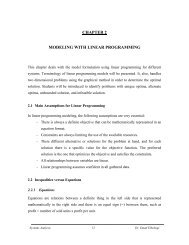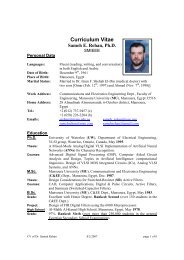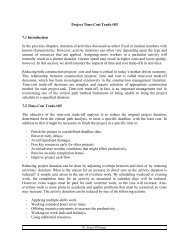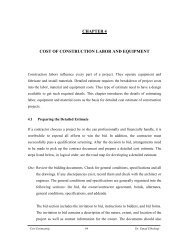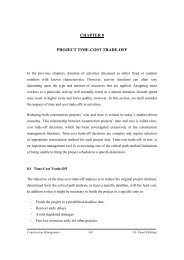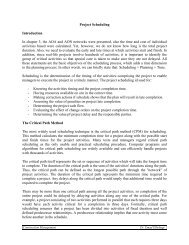Thyroid and Parathyroid
Thyroid and Parathyroid
Thyroid and Parathyroid
You also want an ePaper? Increase the reach of your titles
YUMPU automatically turns print PDFs into web optimized ePapers that Google loves.
Follicular carcinoma usually is solitary <strong>and</strong> approximately 90 percent are surrounded<br />
by a tumor capsule. Follicular carcinoma differs from papillary carcinoma in that<br />
vascular invasion <strong>and</strong> hematogenous spread to bone, lung, <strong>and</strong> liver is seen more<br />
commonly than lymphatic spread, which usually is encountered in late stages. Lymph<br />
node metastases occur in less than 10 percent of patients. Histologically, follicles are<br />
present, but the lumen may be devoid of colloid. Architectural patterns depend on the<br />
. degree of differentiation demonstrated by the tumor<br />
Two types of follicular carcinoma are recognized. In minimally invasive tumors there<br />
is evidence of invasion into but not through the tumor capsule at one or more spots.<br />
Previously, these tumors may have been reported as atypical adenomas, although<br />
there are reports of metastases occurring, <strong>and</strong> they should be regarded as low-grade<br />
carcinomas. In the second type, frankly invasive tumors, there is evidence of vascular<br />
invasion or tumor invasion through the tumor capsule. Tumor infiltration <strong>and</strong> invasion<br />
may be apparent at surgery, with tumor thrombus in the middle thyroid or jugular<br />
. veins<br />
Clinical Manifestations<br />
Follicular cancers usually present as solitary thyroid nodules, occasionally with a<br />
history of rapid size increase, <strong>and</strong> long-st<strong>and</strong>ing goiter. When hemorrhage into the<br />
nodule has occurred, pain may be a presenting feature, but usually the tumors are<br />
painless. At initial presentation cervical lymphadenopathy is uncommon, although<br />
distant metastases are more frequently encountered than papillary carcinoma. Rarely,<br />
follicular cancers may be hyperfunctioning (1 percent), <strong>and</strong> patients may present with<br />
. signs <strong>and</strong> symptoms of thyrotoxicosis<br />
Unless distant metastases have been confirmed as follicular thyroid cancer, definitive<br />
preoperative diagnosis usually is not possible in follicular thyroid carcinoma. This is<br />
because FNAC is unable to distinguish between follicular cells from a benign<br />
follicular adenoma <strong>and</strong> from a carcinoma. Approximately 20 percent of all FNAC<br />
aspirates showing follicular cells are carcinomas; the remaining 80 percent are<br />
. adenomas<br />
Surgical Treatment <strong>and</strong> Prognosis<br />
Patients diagnosed by FNAC as having a follicular lesion should undergo thyroid<br />
lobectomy, including the isthmus <strong>and</strong> the pyramidal lobe. Intraoperative frozensection<br />
examination usually is not helpful but should be performed when there is<br />
evidence of capsular or vascular invasion or when adjacent lymphadenopathy is<br />
present. Total thyroidectomy should be performed when thyroid cancer is diagnosed,<br />
except in patients with minimally invasive follicular cancers because the prognosis in<br />
these patients is so good. In older patients, when follicular neoplasms diagnosed by<br />
FNAC are greater than 4 cm <strong>and</strong> macroscopically suspicious for cancer, some<br />
surgeons proceed with total thyroidectomy, because the risk of cancer is about 50<br />
percent. A diagnosis of invasive carcinoma necessitates completion total<br />
thyroidectomy primarily so that 131I can be used to detect <strong>and</strong> ablate metastatic<br />
disease. Prophylactic nodal dissection is unwarranted because nodal involvement is<br />
. infrequent, but therapeutic neck dissection is recommended<br />
The cumulative percentage of patient mortality from follicular thyroid cancer is about<br />
15 percent at 10 years <strong>and</strong> 30 percent at 20 years. Factors that significantly worsen



